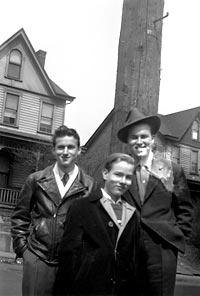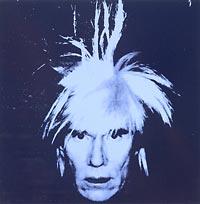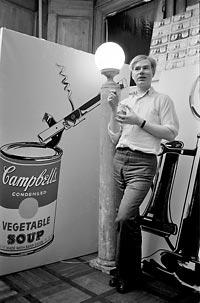PBS documentary looks at the Andy Wahhol's complex, fascinating life

Long before Andy Warhol died in 1987, he had achieved the thing he wanted most: fame.
But it didn't turn out to be the saving grace he'd imagined. While creating a persona for himself as the icon of cool, Warhol used and abused the people who fluttered around him, then placidly watched them self destruct, as if they were nothing but shadows on a screen.
Eventually, one of those troubled hangers-on, a young woman writer, showed up at Warhol's studio with a gun and blasted the celebrity artist in the chest, nearly killing him. She later told police she had to do it: In her mind, Warhol had too much control over her.
As "Andy Warhol" — an American Masters documentary debuting tonight on KCTS, Channel 9 — makes clear, the truth about Warhol's life is complex and often painful. As a New York artist in the 1960s and '70s, he stood at the heart of American culture, high and low. He outraged audiences when he first showed his impeccable renditions of Campbell Soup cans and multiple silk-screened celebrity portraits. Then he won over the public — and the art-world establishment — to become a superstar himself. He blended art, commerce and movie-star glamour into a silvery amalgam that mirrored the American fantasy of success.
Yet he also stood apart from it, a model of passivity who mastered his own emotions by shutting them down. "Everything is just how you decide to think about it," he explained. "Just say 'so what?' "
The two-part, four-hour documentary tells Warhol's fascinating tale from start to finish, unfolding through the insightful comments of interviewees including writers Stephen Koch, John Richardson and George Plimpton; art critic Dave Hickey; Warhol associates Paul Morrissey and Billy Name; and the artist's brother John Warhola. The effusive assessment of the value of Warhol's art by art dealer Irving Blum was interesting but hardly disinterested, given his huge financial gains from the association.
Artist Jeff Koons fills in occasionally as the voice of Warhol and also adds his own oblique comments on him. The rest of the film is narrated by artist/musician Laurie Anderson from a script by Burns and James Sanders. Fortunately the narrative carries less weight than the interviews, because (as in Burns' earlier film on photographer Ansel Adams), the writing tends to be overblown — with statements proclaiming, for example, that Warhol would "alter forever the way people grasp the world around them."
That may be hyperbolic, but Warhol certainly did push through a paradigm shift in the art world, from the heady introspection of abstract expressionism to the mass appeal of Pop art. Warhol accomplished it by making us look at ordinary things as intently as he did. Like many budding artists, Warhol developed that skill as a child.
He was a sickly kid, the youngest of three sons of poor Central European immigrant parents. Born Aug. 6, 1928, in Pittsburgh, Warhol survived a bout with rheumatic fever at age 8 that left him with the condition known as St. Vitus' dance. He was hyper-sensitive to touch and remained subject to spasms and shaking, mood-swings and anxiety. In the long months of his recovery, he stayed in bed reading fan magazines, obsessing on the beautiful people he saw and nurturing a serious crush on Shirley Temple. He drew pictures, filled coloring books and made collages of magazine cut-outs.
Warhol's odd appearance was linked to his childhood illness. He lost pigmentation in his skin, which remained blotchy and pallid. His bad complexion coupled with a big nose, rapidly thinning hair and slight form made Warhol desperately insecure about his looks and sexuality. He began wearing strange wigs to cover his wispy hair. His lack of self-esteem made him inclined to voyeurism as an adult rather than risk direct sexual encounters with the young men who attracted him.
Warhol was only 14 when his father died. Two years later, Warhol's mother, Julia, was hospitalized with colon cancer. Andy's brother John said that during those weeks when the boys had to fend for themselves, he took over the kitchen and made tomato soup and sandwiches for Andy.
The thing that kept Andy going was his fantasy world and making pictures. By the time he enrolled at Carnegie Tech and began studying art seriously, he had developed an extraordinary ability to draw. "He was magnificently talented," one instructor recalled. Another was struck more by Warhol's "great talent for avoiding personal contact."
After he graduated in 1949 (and much to his mother's dismay), Warhol packed up and moved to New York, hoping to make it big. He got a job as an illustrator for Glamour magazine, and the first time his name appeared in print, he discovered that the final "a" in Warhola was left off in typesetting. Rather than correct the mistake, Warhol simply kept his name that way.
If he was passive about some things, Warhol was intensely motivated when it came to his career. He worked hard over the next decade to became the most sought-after commercial artist in New York. He had a distinctive line and liked to compose with repeating patterns and an instinct for what would appeal to the broadest number of people.
That made him a lot of money, but what Warhol really wanted was to make his name as an artist, not a commercial illustrator. He wanted to be friends with the people he idolized. Warhol mooned over Truman Capote, but Capote would have nothing to do with Warhol, categorizing him as a "windowdresser" and a loser. Later, Warhol was also shunned by artists Robert Rauschenberg and Jasper Johns. "Why don't they like me?" Warhol complained to a friend. The response was blunt: "You're too swish and campy."
Part 1 of the documentary focuses on Warhol's childhood and rise to fame. Part 2, airing Thursday, follows the artist down the dark path his celebrity opened up. Warhol made utterly original and provocative films; he made headlines; he attracted a circle of stars, rich socialites and drugged out groupies. In the end, it wasn't a pretty sight. As an artist, Warhol was a mirror of his times and recorder of the dreams and aspirations of the American way of life. What started off all glitter and enchantment turned out to be not just empty, but awful. "Before I was shot I always believed I was watching TV instead of real life," he told a reporter. "I wasn't afraid before. But I'm afraid."
Sheila Farr: sfarr@seattletimes.com


On TV
"Andy Warhol: A Documentary Film," directed by Ric Burns. Part 1 airs at 9 tonight on KCTS (Channel 9), with Part 2 at 9 p.m. Thursday.